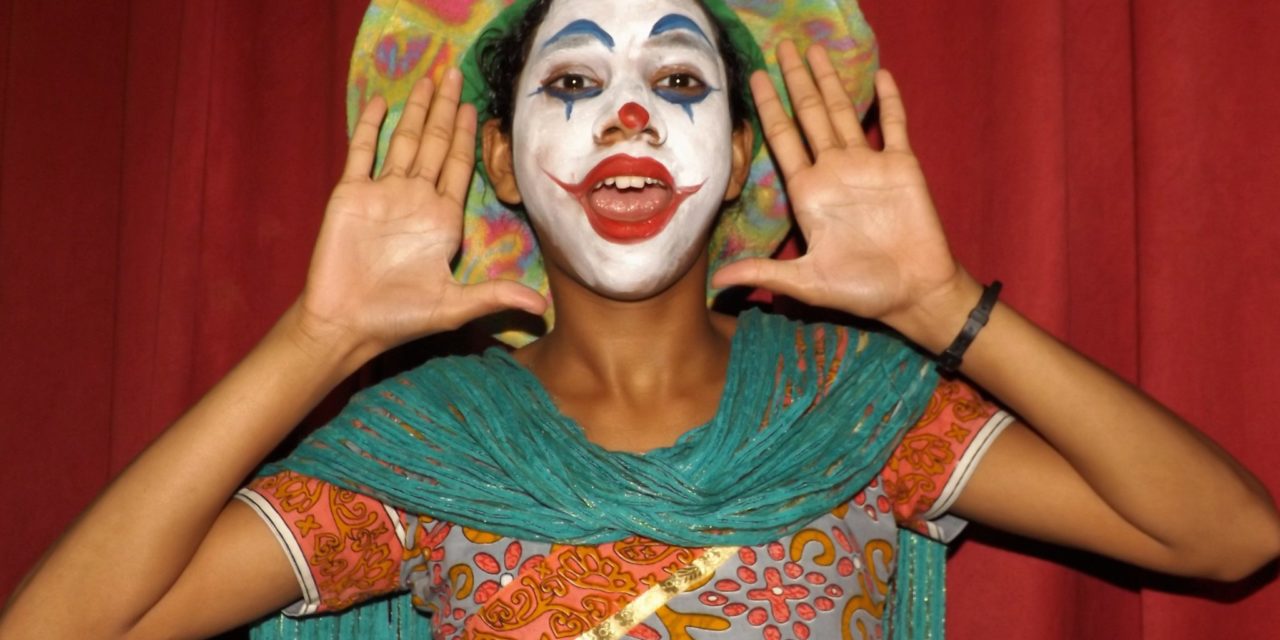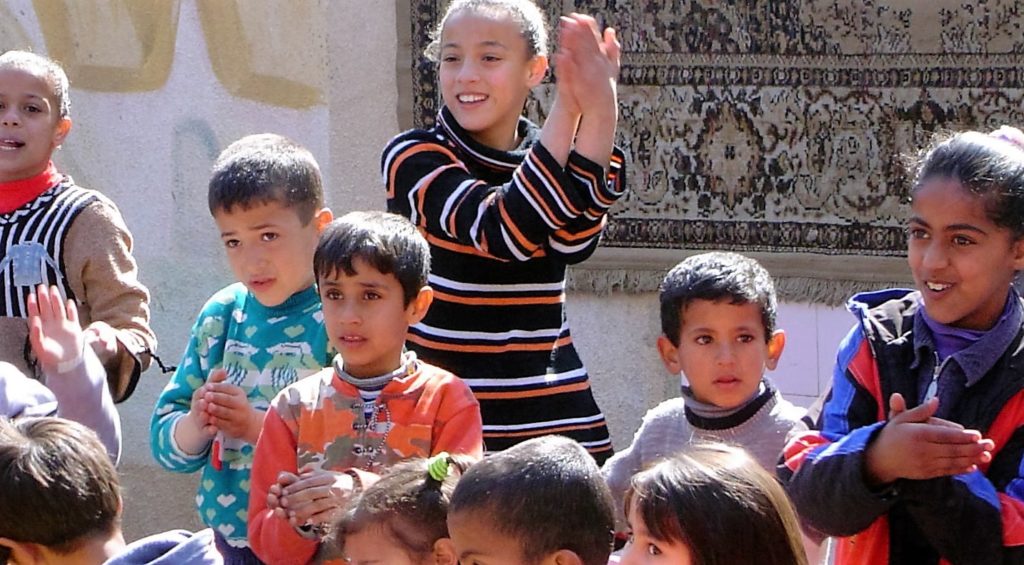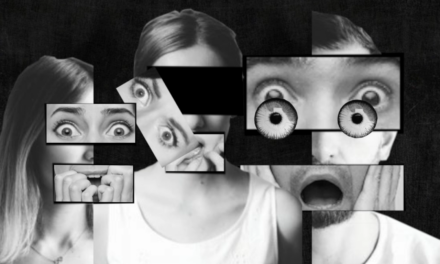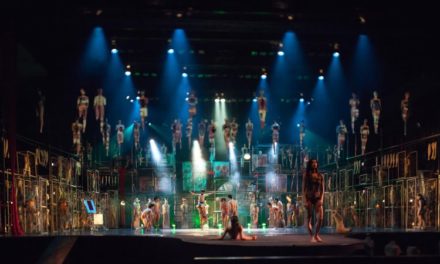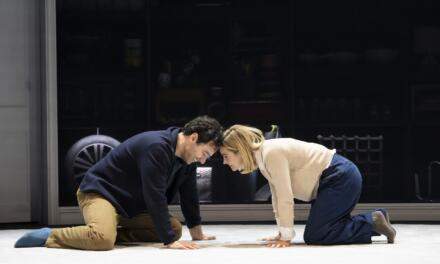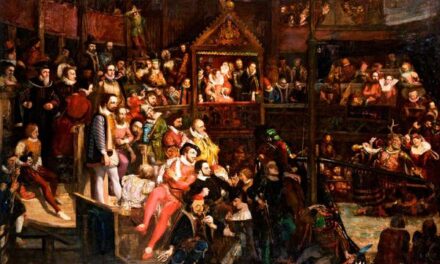“Laughter is the brush that sweeps away the cobwebs of your heart.” – Mort Walker, comic artist
I did a volunteer training program for the medical staff of a leading Jordan medical university. As the attendees were all young people, we tried to keep the sessions lively by spicing things up with some humorous skits using the clown, Dr. von Poofen Spoof, who was our guest speaker – a crazy doctor speaking with a thick German accent dressed in a wild white wig, funny glasses, lab coat, stethoscope, and blue polka dot tie. The doctor illustrated the importance of listening when a patient entered asking for help. Problem was, the patient had an acute stutter as he tried to explain what ailed him, “D…d…d…doctor…It’s my…t..t..t..”
“Ah, just as I thought!” the doctor hastily surmised. Before the patient could get another word out, the doctor gave the patient the usual anesthetic (large foam hammer) and proceeded to extract the patient’s teeth. On awakening him, he found that it wasn’t his teeth but his toe that was bothering him – oops! Should’ve listened!
We as the facilitators weren’t quite sure how all this was going over with the participants so we took some time to listen to their reactions, here is one:
“Being medical students we related to the skits, I liked the idea of therapeutic laughter and would love to see it implemented in our hospitals.” – Hadeel
At the last session, Dr. von Poofen Spoof returned for an encore performance, this time to give some of the medical benefits of laughter using a cauliflower as a model brain, which he pointed to often. Minus the bogus German accent, it went something like this:
“What happens in the brain when we laugh? The neuroendocrine hormones associated with stress response are diminished. The ventromedial prefrontal cortex which produces endorphins is activated.
When we laugh neural paths arise in close association with the telencephalic and diencephalic centres concerned with respiration and our oxygen levels are increased.”
“Hey, we already know this,” one of the students said.
What to me was pure gibberish was just common medical jargon to them. I guess that’s why I’m a clown and not a medical student.
The first time I acted out Dr. von Poofen Spoof, it was at the opening of the local children’s museum in Jordan. I was asked to be a ‘mad scientist’ to perform science experiments. It seems that kids like to learn more from a crazy scientist than a stuffy lab technician, so in the style of “Bill Nye the Science Guy” I mixed a bit of humor in with the science.
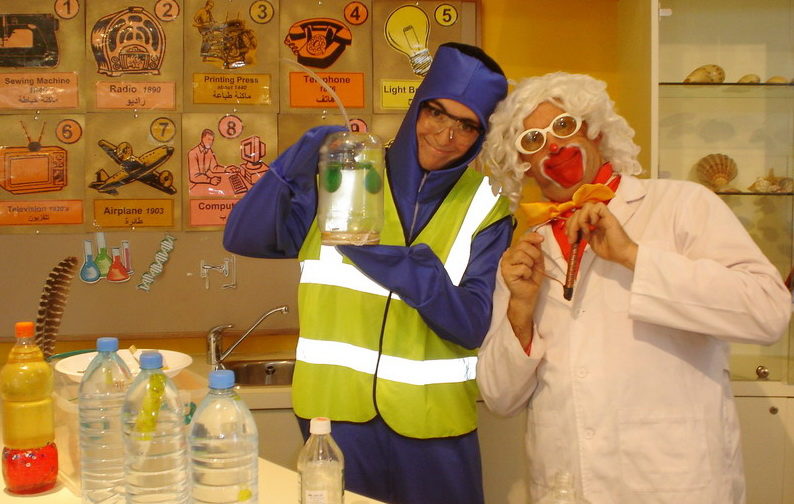
Clown Professor Dr. von Poofen Spoof and his robot performing at the opening of the Science Museum
Oh, by the way, that was the only time in my life I ever shook hands with royalty. Their majesties were touring all the exhibits at the opening of the museum and greeted me with a cheery smile and warm handclasp to cheer me on. It was quite humbling to meet royalty dressed as a nut!
But hey, that is what humor is all about – having a good laugh at yourself, and how ridiculous we can sometimes be. As someone once said, “The person who knows how to laugh at himself will never cease to be amused.” (Shirley Mac Laine)
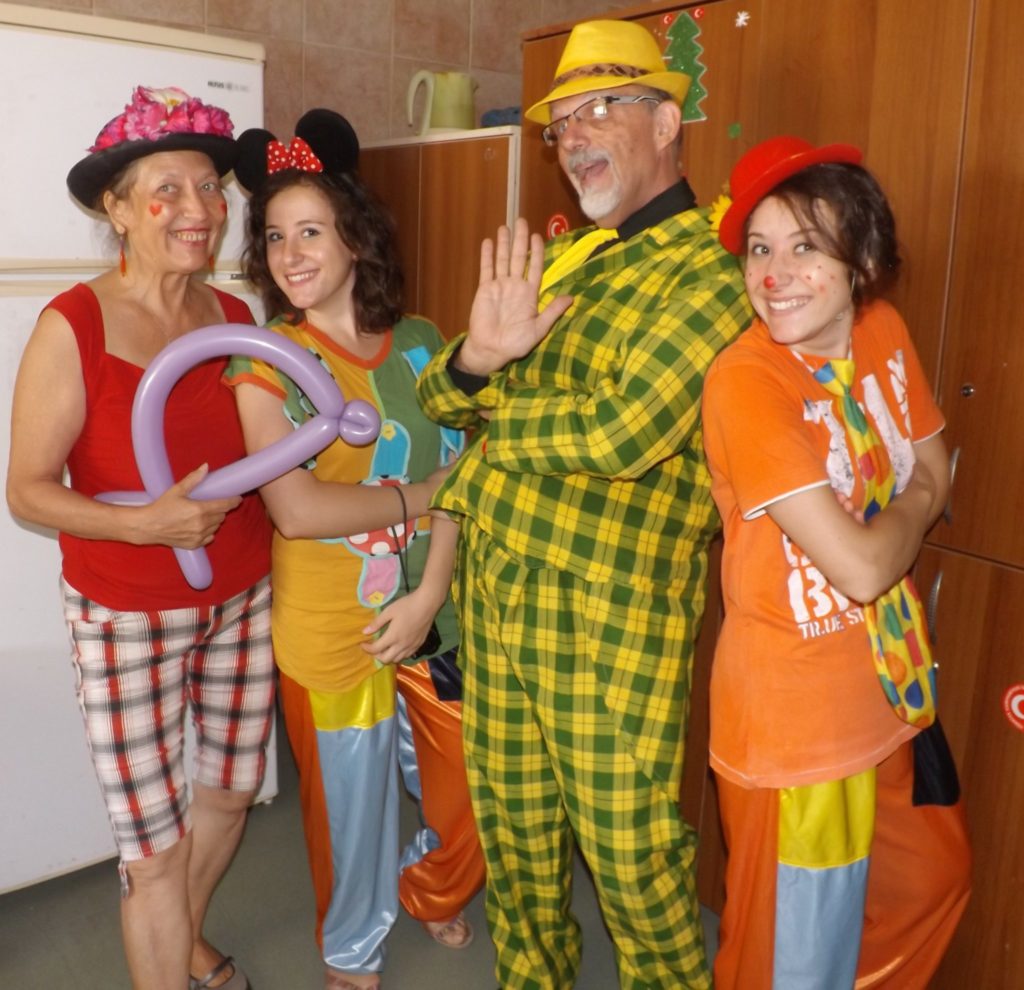
Clown therapy at a children’s hospital in Adana, Turkey. A group of Turkish volunteers went around to the children’s beds and cheered them up with balloons, some clown magic, and lots of laughs. Although we had some basic ideas, we used improvisation a lot – finding fun in the moment.
During my experience as a clown, I have been surprised at the response and demand for clowns, we have sometimes done close to 300 clown shows a year! It seems that people who can encourage fun, enjoy life, and reduce stress in others are in great demand everywhere in the world.
In Palestine my clown colleague, Marco found it very effective to use clown therapy to help children overcome their fears brought on by war.
As Mark Twain said, “Against the assault of laughter nothing can stand. The human race has only one really effective weapon, and that is laughter.”
One comedian, who suffered some tragic losses in his life own life said, “You can turn painful situations around through laughter. If you can find humor in anything, even poverty, you can survive it.”
Throughout the years we have worked together with many institutions to bring joy to others through ‘clown therapy.’ We have often visited hospitals to cheer up young cancer patients by entertaining them and involving them in fun games and songs. We have cooperated with “Operation Smile,” which operates free medical clinics for the needy. Our job was to entertain the patients as they waited to be treated. Our clown team accompanied the Bedouin Health Awareness Project to help children learn about personal hygiene. We traveled several hours to remote Bedouin rural schools with a medical expert to impart this health message to the children there. Portraying the message with puppets, humor, and vivid props such as a giant toothbrush was very effective. It seems most people realize that when we laugh – we listen.
My career started as a clown from humble origins. We were in Uganda, Africa, when Simon a colleague of mine asked for my assistance to do a clown performance at a rural school.
“Sure, glad to help, but there is a small problem. I have never been a clown before and I don’t have a costume.”
“No worries! Just wear something funny and act a bit goofy and that should do.”
With that simplistic explanation, I gathered an odd collection of clothes added a pair of bright red suspenders, donned an overly large colorful hat and we were off.
After driving several hours, we arrived at the school, where we were greeted as if we were ambassadors from a prestigious nation. All the student body turned out with the principal.
Then after donning our costumes the show began, Simon swung right into action as the pro that he was with clown magic, the classic rubber chicken routine, and lots of fun and gags. We even got some character building in by using object lessons from what was available – which wasn’t much. Sprinkling salt on the audience, we encouraged everyone to be like the salt – enhance your situation by making it better – etc. The village school loved it and told us many times that it was a highlight of their year. A little fun and laughter really does go a long way! After that, I was sold on the idea and began to develop my clowning skills. Although it is true that the art of clowning may not be ‘rocket science,’ it is a skill that can be developed to a higher level through training. Our clown troupe went on to do clown shows in prisons, schools for the deaf and disadvantaged, and many more venues.
Clowning has brought me to many new cities in India and abroad that I wouldn’t have visited otherwise. In my travels, I often come across interesting people and fellow performers that I bond with such as Charlie Chaplin II and Mr. Banana. Each has their own story that impresses me the value of entertainment to open doors both for support as well as making others happy. I feel that there is a lot we can still develop in this field. I have started to ask people for their life story in an interview form and ask relevant questions to draw out aspects of their life for their reflection and for us to apply as well. We can listen carefully to their story and draw those lessons out.
A good friend of mine, Jan Tomasz Rogala, gives training in clowning skills to bring cheer and encouragement to children in hospitals and in many other venues. You can check out his activities at:
http://doctorclown.org/eng/index.html
I would like to share with you a good explanation I came across of why clowns are popular and what makes them work:
Clowns operate where the unexpected is the rule. As with the red nose – he is happy to appear stupid. He is not afraid to make a fool of himself. He is vulnerable and happy to be so. He draws attention to the eyes and mouth, the expressive parts of the face. The nose magnifies the movements of the face, alerting the spectator that the gesture on display is to be watched.
The clown is one of the purest forms of improvisation. None of the things the clown does are ever guaranteed. Everything is on the brink of ‘the cup’ (disaster or failure) – because everything is real. He is part of the search for what is laughable and ridiculous in man. He finds things about himself that are funny and plays on them. He understands his own rhythms his own ways of being and magnifies those for his audience, happy to be vulnerable and honest about himself.
He finds what is genuine in the moment and leaves aside the habit of performance. He is truthful with himself. He goes on unarmed, expectant, open to the context in which he finds himself. The clown has an encounter with the audience and always underscores the frailty and miracle of creation.
- Lecoq, from the book Teaching Classroom Drama and Theatre, by Martin Lewis and John Rainer
This post was written by the author in their personal capacity.The opinions expressed in this article are the author’s own and do not reflect the view of The Theatre Times, their staff or collaborators.
This post was written by Curtis Peter van Gorder.
The views expressed here belong to the author and do not necessarily reflect our views and opinions.

